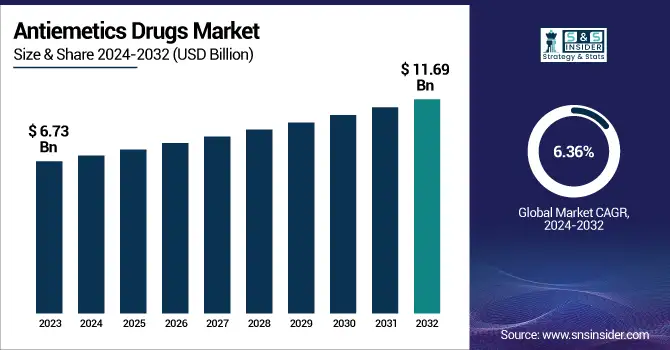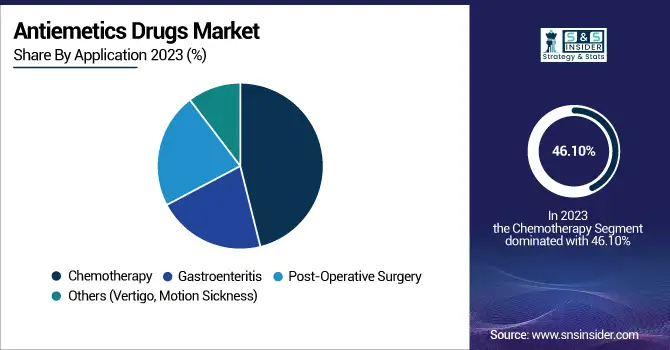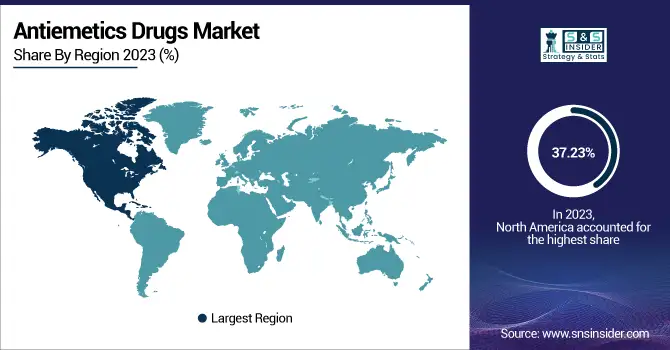Antiemetics Drugs Market Size Analysis:
The Antiemetics Drugs Market was valued at USD 6.73 billion in 2023 and is expected to reach USD 11.69 billion by 2032, growing at a CAGR of 6.36% from 2024-2032.

To Get more information on Antiemetics Drugs Market - Request Free Sample Report
This report provides a unique statistical analysis of the Antiemetics Drugs Market, presenting condition-specific incidence and prevalence figures to trace demand sources across regions. It especially monitors prescription trends by therapeutic class and geography, with the aid of a comparative picture of pharmaceutical expenditure stratified by type of payer (government, commercial, private, out-of-pocket) in 2023. The report also gives a specialized description of regulatory approvals and market access behavior, highlighting approval times and regional differences. It includes a branded vs. generic drug market share split, providing unusual insight into competitive positioning and pricing trends—factors frequently underrepresented in typical market analyses.
The U.S. Antiemetics Drugs Market was valued at USD 2.06 billion in 2023 and is expected to reach USD 3.56 billion by 2032, growing at a CAGR of 6.30% from 2024-2032.
The U.S. maintains a leading position in the North American antiemetics drugs market due to high incidences of cancer and gastrointestinal conditions, sophisticated healthcare infrastructure, and robust pharmaceutical R&D. Extensive use of chemotherapy and supportive care drugs also supports its leadership position. In addition, the availability of key market players and positive FDA approvals for emerging antiemetic treatments are the key drivers of long-term growth. Growing outpatient surgeries and increasing awareness of effective control of nausea and vomiting also aid the U.S.'s leading position in the region.
Antiemetics Drugs Market Dynamics
Drivers
-
The growing worldwide cancer burden is largely propelling the need for antiemetic medications.
Nausea and vomiting induced by chemotherapy (CINV) are two of the most unpleasant side effects for cancer patients, and they require effective antiemetic regimens. The American Cancer Society estimates that more than 1.9 million new cases of cancer were diagnosed in the U.S. alone in 2023, and a large percentage of these patients receive chemotherapy. As increasingly aggressive and advanced cancer treatments are being implemented worldwide, supportive care, including antiemetic administration, has experienced parallel growth. New developments, such as the FDA's fast-track approval of combination regimens like netupitant-palonosetron (Akynzeo), are improving the standard of care. Greater availability of guideline-based protocols by organizations like NCCN and ASCO further drives the utilization of antiemetics in oncology practice.
-
Expanding Surgical Procedures and Post-operative Care are driving the market growth.
The worldwide increase in surgical procedures—both elective and emergency—has been responsible for a growth in the use of antiemetics in controlling post-operative nausea and vomiting (PONV). According to the World Health Organization, an estimated 330 million surgeries are conducted annually worldwide, with a large percentage of patients in need of antiemetic therapy. PONV occurs in as many as 30% of all surgical patients and as many as 80% of high-risk patients. With increasing awareness of the trend toward minimally invasive and ambulatory surgeries, healthcare professionals are more concerned about maximizing recovery pathways, for which antiemetic therapy is instrumental. Recent innovations have entailed the broader clinical application of medications such as ondansetron and dexamethasone in Enhanced Recovery After Surgery (ERAS) regimens. This trend, coupled with increased patient satisfaction expectations, further underscores the sustained demand for antiemetic therapies.
Restraint
-
Adverse Effects and Drug Interactions Limiting Long-Term Use are restraining the market growth.
Even though they have therapeutic advantages, antiemetic drugs tend to be accompanied by a variety of side effects that may restrict their long-term or extensive utilization. Sedation, dizziness, constipation, extrapyramidal side effects, and QT interval prolongation are some general side effects that occur with dopamine receptor antagonists and serotonin (5-HT3) receptor antagonists. These side effects can hurt patient compliance and physician prescribing behavior, particularly in sensitive patients such as the elderly, pediatric patients, or cardiovascular patients. Additionally, drug–drug interactions are of increasing importance, as the majority of antiemetic users are already placed on polypharmacy therapy, particularly in oncology and post-surgical settings. For instance, coadministration of aprepitant with warfarin or dexamethasone necessitates meticulous dose adjustment. These safety issues tend to require alternative treatments or further surveillance, thus serving as a deterrent to the development and use of antiemetic drugs.
Opportunities
-
Growth in Emerging Markets and Access to Generics are creating the opportunity for the market.
The growth of healthcare infrastructure and enhanced pharmaceutical availability in emerging markets offer a robust growth prospect for the antiemetics drugs market. Nations in Asia Pacific, Latin America, and regions of Africa are experiencing growing cancer incidence, higher surgical volumes, and wider awareness of gastrointestinal disorders—conditions that frequently necessitate antiemetic therapy. Moreover, government efforts to make essential drugs part of public health programs have made access to cheap generic antiemetics such as ondansetron and metoclopramide more widespread. Generic players are also focusing on these markets more and more because of their cost advantages and volume-driven demand. With better health care funding, auspicious regulatory reforms, and increasing numbers of retail pharmacies and hospital chains, these areas present attractive markets for both branded and generic antiemetic drugs and provide pharmaceutical firms with an untapped but fast-expanding consumer base.
Challenges
-
Patent Expiry and Intense Generic Competition are challenging the market to grow.
Some of the major challenges in the antiemetics drugs market include patent expiration of key branded drugs, which have brought in generic versions. This change has heightened price-based competition, particularly in mature markets such as North America and Europe, where cost-containment pressure is intense. Branded products such as Zofran (ondansetron) and Emend (aprepitant) have suffered generic erosion, significantly affecting revenue streams of originators. With healthcare systems emphasizing cost-containment, payers tend to favor generics over branded drugs, making it challenging for producers to sustain premium pricing. Further, the large number of generic entrants has led to price deflation and compressed profit margins. For pharmaceutical firms, the survival of market share in such a competition requires a heavy investment in brand differentiation, combination therapy, and lifecycle management strategies, which are time-consuming and resource-intensive.
Antiemetics Drugs Market Segmentation Analysis
By Drug Type
The serotonin-receptor antagonist segment dominated the antiemetic drugs market with 28.45% market share in 2023. Due to their extensive clinical use, excellent efficacy, and favorable safety profile in treating nausea and vomiting, particularly in chemotherapy, radiation, and post-operative settings. Because they can block 5-HT3 receptors both centrally and peripherally, medications like ondansetron, granisetron, and palonosetron are regarded as the gold standard for treating chemotherapy-induced nausea and vomiting (CINV) and post-operative nausea and vomiting (PONV). Furthermore, these medications are prescribed more frequently because they are listed in important international clinical guidelines (such as the NCCN, ASCO, and MASCC) for first-line antiemetic treatment. The segment also benefits from the availability of generics and a broad range of dosage forms (oral, injectable, and ODT), which have increased accessibility in both developed and emerging markets. Serotonin-receptor antagonists were positioned as the top drug class in 2023 due to their strong combination of clinical reliability and commercial availability.
By Application
The chemotherapy segment dominated the antiemetics drugs market with a 46.10% market share in 2023 because of the high incidence of cancer worldwide and the extensive use of cytotoxic agents, which frequently cause nausea and vomiting. Antiemetic regimens are routinely prescribed as part of standard oncological care because chemotherapy-induced nausea and vomiting (CINV) is still one of the most upsetting side effects for cancer patients. Particularly in wealthy nations with access to cutting-edge cancer treatment protocols, the use of multidrug antiemetic protocols, which frequently include corticosteroids, neurokinin-1 receptor antagonists, and serotonin-receptor antagonists, has grown dramatically. Widespread use has also been made easier by regular revisions to clinical practice guidelines, the addition of antiemetics to national formularies, and insurance coverage. In 2023, chemotherapy was firmly established as the main application area due to its clinical necessity and regulatory backing.
The post-operative Surgery segment is forecasted to experience the fastest growth in the forecast years, fueled by the global increase in elective and minimally invasive surgeries. Enhanced Recovery After Surgery (ERAS) guidelines, increasingly implemented in hospitals and operating centers, focus on preventing post-operative nausea and vomiting (PONV) to minimize patient discomfort and length of hospital stay. PONV occurs in as many as 80% of high-risk surgical patients, and antiemetic administration is an essential part of perioperative management. Improved anesthesia, reduced hospital stays, and increased day-care procedures further increase the need for effective and well-tolerated antiemetics with rapid onset of action. The increase in outpatient procedures, combined with initiatives to enhance post-operative patient satisfaction and safety, is expected to drive aggressive growth in this segment in both developed and emerging healthcare systems.

By End-use
The Retail Pharmacy segment dominated the Antiemetics Drugs Market with 50.09% market share in 2023 because of the growing demand for over-the-counter (OTC) and prescription-based antiemetic drugs, especially for general conditions such as motion sickness, gastroenteritis, and nausea during pregnancy. Retail pharmacies provide an easy and accessible point of care for patients who require instant relief, particularly in non-hospital settings. Ease of access to generics like ondansetron, domperidone, and promethazine in tablet and dissolvable presentations has further promoted self-medication and intervention by pharmacists. The international spread of retail pharmacy chains and e-pharmacy sites has been a driving force behind enhanced access to antiemetics in both urban and semi-urban parts of the country. As customers become more aware of their available medication choices and the use of outpatient care and telemedicine prescriptions gains ground, they are relying more on retail channels for their medication requirements. These trends, in combination, served to reinforce the preeminence of retail pharmacies in 2023.
Antiemetics Drugs Market Regional Analysis
North America dominated the antiemetics drugs market with a 37.23% market share in 2023 due to its well-developed healthcare infrastructure, high level of health expenditures, and prominent foothold of major pharmaceutical companies. The region has a high prevalence of diseases like cancer, gastrointestinal disorders, and post-operative conditions that frequently necessitate antiemetic therapy. Support from authorities such as the FDA, combined with expedited drug approvals and widespread insurance coverage, additionally contributes to market expansion. Furthermore, early uptake of cutting-edge therapies and a wide patient base that is receiving chemotherapy and other therapies causing nausea and vomiting support North America's market dominance.
Asia Pacific is the fastest-growing region in the antiemetics drugs market with 6.32% CAGR as a result of improving healthcare awareness, rising access to medical facilities, and enhanced investments in healthcare infrastructure. The area is experiencing growth in cancer and gastrointestinal disease incidence, along with rising diagnostic rates. Growing pharmaceutical markets in China and India, favorable government policies, and greater availability of generics make antiemetic treatments more available and cost-effective. In addition, a vast population base and changing treatment patterns play an important role in the high-speed market growth in the Asia Pacific.

Get Customized Report as per Your Business Requirement - Enquiry Now
Antiemetics Drugs Market Key Players
-
Pfizer Inc. (Zofran, Phenergan)
-
GlaxoSmithKline plc (Zofran ODT, Kytril)
-
Johnson & Johnson (Emend, Motilium)
-
Sanofi S.A. (Aloxi, Domperidone)
-
Novartis AG (Zofran Injection, Compro)
-
Merck & Co., Inc. (Emend IV, Aprepitant)
-
Baxter International Inc. (Prochlorperazine, Ondansetron Injection)
-
F. Hoffmann-La Roche Ltd (Aloxi, Kytril Injection)
-
Boehringer Ingelheim International GmbH (Metoclopramide, Granisetron)
-
Teva Pharmaceutical Industries Ltd. (Ondansetron, Prochlorperazine Maleate)
-
Dr. Reddy's Laboratories Ltd. (Domperidone, Ondansetron ODT)
-
Mylan N.V. (Meclizine Hydrochloride, Promethazine Hydrochloride)
-
Sun Pharmaceutical Industries Ltd. (Granisetron Injection, Palonosetron)
-
Cipla Ltd. (Domperidone Suspension, Ondansetron Tablets)
-
Aurobindo Pharma Ltd. (Prochlorperazine Tablets, Granisetron Tablets)
-
Torrent Pharmaceuticals Ltd. (Levocetirizine + Montelukast, Domperidone MD)
-
Zydus Lifesciences Ltd. (Ondem, Vomistop)
-
Lupin Limited (Emeset, Domstal)
-
AbbVie Inc. (Marinol, Maviret [used adjunctively])
-
Endo International plc (Promethegan, Zenzedi [off-label use])
Suppliers (These suppliers primarily provide pharmaceutical excipients such as binders, disintegrants, coatings, stabilizers, and API intermediates essential for formulating antiemetic drugs across various delivery forms like tablets, injections, and oral suspensions) in the Antiemetics Drugs Market
-
BASF SE
-
Evonik Industries AG
-
Ashland Global Holdings Inc.
-
DuPont de Nemours, Inc.
-
Colorcon Inc.
-
DFE Pharma
-
Roquette Frères
-
Lubrizol Life Science
-
Croda International Plc
-
Merck KGaA (MilliporeSigma)
Recent Developments in the Antiemetics Drugs Market
-
March 11, 2025 – Arvinas, Inc. and Pfizer Inc. announced positive Phase 3 VERITAC-2 trial data, demonstrating vepdegestrant monotherapy superiority over fulvestrant in ER+/HER2- advanced breast cancer patients who had been treated with CDK4/6 inhibitors and endocrine therapy. Vepdegestrant is an oral PROTAC ER degrader with potential first-in-class properties.
-
June 3, 2024 – The IMROZ Phase 3 trial demonstrated that Sarclisa (isatuximab) in combination with VRd and then Sarclisa-Rd decreased the risk of disease progression or death by 40% compared with VRd and then Rd in patients with newly diagnosed, transplant-ineligible multiple myeloma.
| Report Attributes | Details |
|---|---|
| Market Size in 2023 | US$ 6.73 Billion |
| Market Size by 2032 | US$ 11.69 Billion |
| CAGR | CAGR of 6.36 % From 2024 to 2032 |
| Base Year | 2023 |
| Forecast Period | 2024-2032 |
| Historical Data | 2020-2022 |
| Report Scope & Coverage | Market Size, Segments Analysis, Competitive Landscape, Regional Analysis, DROC & SWOT Analysis, Forecast Outlook |
| Key Segments | • By Drug Type (Serotonin-Receptor Antagonists, Anticholinergics, Dopamine Receptor Antagonists, Neurokinin Receptor Antagonists, Others [Antihistamines, Cannabinoids]) • By Application (Chemotherapy, Gastroenteritis, Post-Operative Surgery, Others [Vertigo, Motion Sickness]) • By End-use (Hospital & Clinics, Retail Pharmacy, Others) |
| Regional Analysis/Coverage | North America (US, Canada, Mexico), Europe (Eastern Europe [Poland, Romania, Hungary, Turkey, Rest of Eastern Europe] Western Europe] Germany, France, UK, Italy, Spain, Netherlands, Switzerland, Austria, Rest of Western Europe]), Asia Pacific (China, India, Japan, South Korea, Vietnam, Singapore, Australia, Rest of Asia Pacific), Middle East & Africa (Middle East [UAE, Egypt, Saudi Arabia, Qatar, Rest of Middle East], Africa [Nigeria, South Africa, Rest of Africa], Latin America (Brazil, Argentina, Colombia, Rest of Latin America) |
| Company Profiles | Pfizer Inc., GlaxoSmithKline plc, Johnson & Johnson, Sanofi S.A., Novartis AG, Merck & Co., Inc., Baxter International Inc., F. Hoffmann-La Roche Ltd, Boehringer Ingelheim International GmbH, Teva Pharmaceutical Industries Ltd., Dr. Reddy's Laboratories Ltd., Mylan N.V., Sun Pharmaceutical Industries Ltd., Cipla Ltd., Aurobindo Pharma Ltd., Torrent Pharmaceuticals Ltd., Zydus Lifesciences Ltd., Lupin Limited, AbbVie Inc., Endo International plc, and other players. |

